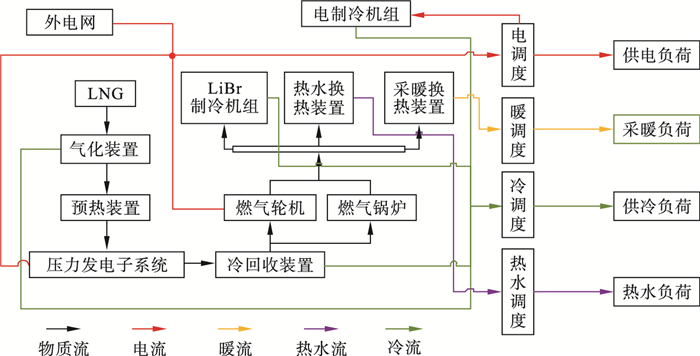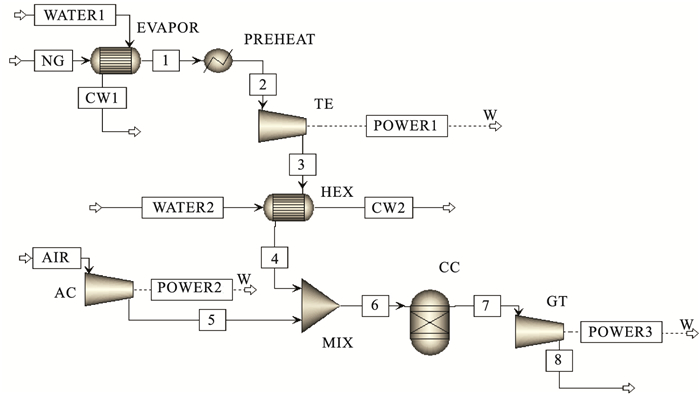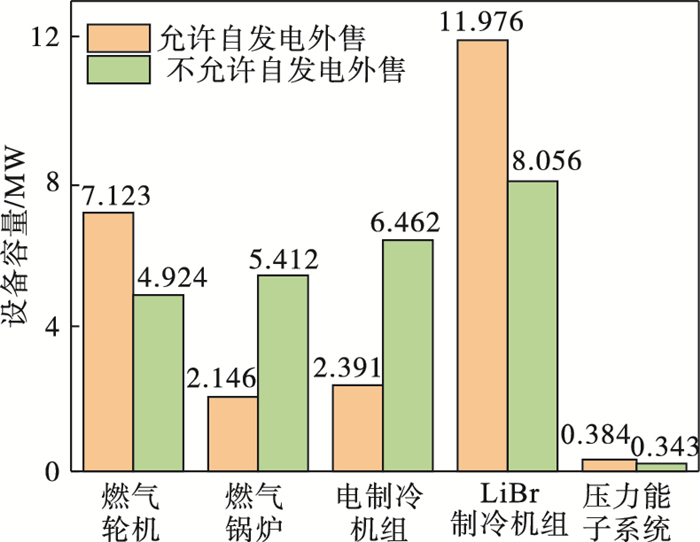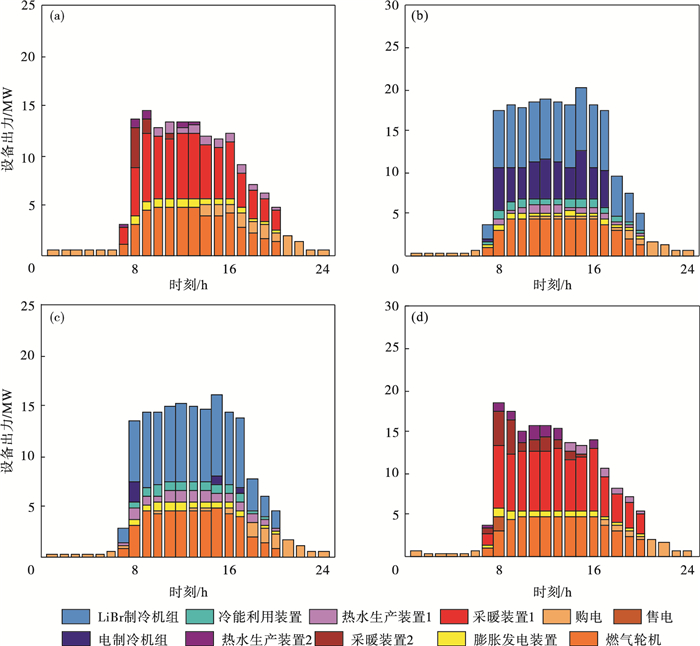
 , 赵梅玉2, 周乐1
, 赵梅玉2, 周乐1 1. 东北大学 冶金学院, 辽宁 沈阳 110819;
2. 北京精仪天和智能装备有限公司 技术中心, 北京 100079
收稿日期:2021-07-25
基金项目:国家重点研发计划项目(2017YFA0700302)。
作者简介:冯明杰(1971-),男,河南禹州人,东北大学副教授。
摘要:提出了一种耦合液化天然气压力能的新型冷-热-电联供(CCHP, combined cooling, heating and power)系统.以西安某工业园为研究对象, 采用单纯形算法, 以经济性最优为目标函数对系统的运行参数进行了优化, 分析了电上网政策对设备出力和系统性能的影响, 并以能效、火用效和单位产能CO2排放量作为评价指标, 对该系统进行了综合评价.结果表明, 与常规CCHP系统相比, 该新型系统的年费用和单位产能CO2排放量可分别减少2.9×106元和29.82 g/(kW · h), 一次能源利用率和火用效率可分别提高4.05 % 和0.44 %.
关键词:压力能冷-热-电联供运行策略年总费用
Construction and Optimization of CCHP System Coupled with LNG Pressure Energy
FENG Ming-jie1, WANG Deng-liang1

 , ZHAO Mei-yu2, ZHOU Le1
, ZHAO Mei-yu2, ZHOU Le1 1. School of Metallurgy, Northeastern University, Shenyang 110819, China;
2. Technology Center, Beijing Jingyi Tianhe Intelligent Equipment Co., Ltd, Beijing 100079, China
Corresponding author: WANG Deng-liang, E-mail: wangdengliang0@163.com.
Abstract: A novel type of combined cooling, heating and power(CCHP)system coupled with LNG pressure energy has been proposed. Taking an industrial park in Xi ′an as the research object, an optimization model with the objective of economic optimization was established by using simplex algorithm. In addition, some parameters, such as energy efficiency, exergy efficiency and CO2 emission per unit output value were taken as evaluation indexes to comprehensively evaluate the new system, and the influence of feed-in tariff on the output of various equipment and system performance was analyzed. The performance of the novel CCHP system was compared with that of conventional CCHP system, and the CO2 emission per unit output value and annual cost of the system were reduced by 29.82 g/(kW · h) and 2.9×106 CNY, respectively. Primary energy utilization and exergy efficiency increased by 4.05 % and 0.44 %, respectively.
Key words: pressure energyCCHP(combined cooling, heating and power)operation strategytotal annual expenses
随着工业的进步, 化石燃料的消耗迅速增加, 节能降耗是目前世界上极为关注的问题.冷-热-电联供(combined cooling, heating and power, CCHP)系统在能量分级利用的基础上, 能同时满足用户对冷、热、电的需求, 一次能源利用率达80 % 以上, 是一种高效的能源利用系统[1].天然气作为一种优质的清洁能源, 具有污染小、运输方便等优势, 是冷-热-电联供系统常用的燃料, 以天然气为主能源的冷-热-电联供系统的构建和运行优化是未来能源领域的重要发展方向和目前的研究热点[2].众多****从不同的角度、采用不同的策略对此开展了研究[3-8].液化天然气(LNG)具有很高的压力, 其压力能极为可观[9-10].目前已有****对液化天然气压力能的综合利用开展了一些研究[11-13], 但总的来看研究还不够充分, 尚有较大的可利用空间.本文构建了一种耦合液化天然气压力能的新型CCHP系统, 充分利用液化天然气的压力能来发电和制冷, 以进一步提高能源的综合利用率.同时采用单纯形算法, 以经济性最优为目标函数对系统运行参数进行了优化, 以能效、火用效和单位产能CO2排放量作为评价指标, 对该系统进行综合评价, 并分析了电上网政策对系统运行及性能的影响.
1 系统流程构建的新型CCHP系统如图 1所示, 主要由天然气压力能利用子系统[14]、燃气轮机(包括燃烧室)、电制冷机组、LiBr吸收式制冷机组以及燃气锅炉等组成.高压液化天然气采用气化装置气化, 用气化过程中产生的冷能来制取冷水, 气化完成后的天然气经预热装置预热后[15]进入压力发电子系统做功后进入冷回收装置(气化装置和冷回收装置合称为压能制冷子系统), 随后进入燃气轮机发电.产出的电能, 一部分为用户提供电负荷, 另一部分当冷回收装置和LiBr吸收式制冷机组无法满足用户冷能需求时, 驱动电制冷机组制冷.燃气轮机排出的高温烟气被分成3部分:供给LiBr吸收式制冷机组、通过热水换热装置制取热水、通过采暖换热装置为用户提供采暖热负荷.提供的采暖热负荷或热水量无法满足用户需求时, 则通过燃气锅炉进行补偿.系统的自发电无法满足用户的需求时, 从市政电网购电以作补充.此外, 当系统的自发电多于用户需求时, 可以出售给市政电网.与传统的CCHP联供系统相比, 该系统增加了天然气压力能利用子系统[16-18](如图 2所示), 其中各设备的运行参数如表 1所示.
图 1(Fig. 1)
 | 图 1 耦合液化天然气压力能的新型CCHP系统Fig.1 Novel CCHP system coupled with LNG pressure energy |
图 2(Fig. 2)
 | 图 2 天然气压力能利用子系统Fig.2 Natural gas pressure energy utilization system |
表 1(Table 1)
| 表 1 设备的运行参数 Table 1 The operating parameters of each equipment |
2 优化模型2.1 优化目标函数以经济性最佳为优化目标(即系统的年费用最小), 其中年费用主要包括系统的投资费、运行和维护费以及系统的购电费并除去售电收益.计算式如式(1)所示:
 | (1) |
系统的年投资费:
 | (2) |
令frec为资本回收系数:
 | (3) |
则有:
 | (4) |
 | (5) |
 | (6) |
 | (7) |
 | (8) |
系统的年运行费:
 | (9) |
 | (10) |
 | (11) |
 | (12) |
系统的维护费:
 | (13) |
 | (14) |
 | (15) |
 | (16) |
 | (17) |
 | (18) |
系统的年购电费:
 | (19) |
系统的年售电收益:
 | (20) |
2.2 决策变量决策变量包括系统中各设备的设备容量(Pratpgu, Pratec, Pratac, Pratb和Pratgpue)和运行参数(Euserspgu, Eecpgu, Esalepgu, Eusersgrid, Eecgrid, Huserspgu, HWuserspgu, Husersb, HWusersb和Hacpgu).
2.3 约束条件1) 能量约束.系统需要同时满足用户的冷、采暖、热水和电需求, 即
 | (21) |
 | (22) |
 | (23) |
 | (24) |
其中:
 | (25) |
 | (26) |
 | (27) |
 | (28) |
 | (29) |
 | (30) |
2) 设备能力约束.系统运行时必须保证各设备(单元)的实际运行功率不超过额定功率.
天然气压力能利用子系统的约束条件为
 | (31) |
 | (32) |
 | (33) |
LiBr吸收式制冷机组的约束条件为
 | (34) |
 | (35) |
 | (36) |
3 应用案例以西安市某工业园为研究对象, 园区内有100 000 m2的建筑需提供冷、热、生活热水和电负荷.4个季节典型日的负荷需求如图 3所示, 其中, 夏季供冷, 冬季供热, 春秋季是过渡季节, 既不供冷也不供热, 全年的电负荷需求基本稳定, 春冬季节的生活热水需求高于夏秋季节, 但在每日的0:00~6:00和21:00~24:00时间段里只有电需求.利用建立的优化模型及评价指标对该案例进行优化与评估, 计算基于Matlab9.0平台开展, 采用单纯形算法对模型进行优化求解.
图 3(Fig. 3)
 | 图 3 典型日负荷需求Fig.3 Load demand of typical days in four seasons (a)—春季; (b)—夏季; (c)—秋季; (d)—冬季. |
4 结果及分析优化后的设备最优容量如图 4所示.由图可知, 允许自发电上网销售时, 燃气轮机、吸收式制冷机组和压力能利用子系统的设备容量比不允许上网销售时分别增加44.65 %, 48.66 % 和10.6 %, 燃气锅炉和电制冷则分别减小60.34 % 和62.99 %.
图 4(Fig. 4)
 | 图 4 系统优化后的设备容量Fig.4 Equipment capacity after optimization |
自发电能上网销售时, 系统运行参数的优化结果如图 5所示.从图中可以看出, 不同季节系统典型日中自发电的变化规律相似, 每日7:00~20:00, 燃气轮机承担了园区用电需求的绝大部分, 而压力能利用子系统承担了剩余部分; 每日20:00至次日7:00, 用电需求则全部由市政电网来承担.从图中还可以看出, 系统的自发售电量, 夏冬季要比春秋季多.
图 5(Fig. 5)
 | 图 5 允许发电上网销售时系统运行参数优化结果Fig.5 Optimization results of the operation parameters when electricity is allowed to be sold (a)—春季; (b)—夏季; (c)—秋季; (d)—冬季. |
自发电不能上网销售时, 系统运行参数的优化结果如图 6所示.从图中可以看出, 自发电不能上网销售时系统运行参数的优化结果与自发电能上网销售的优化结果存在较大差异.春冬季节, 园区的热负荷需求较多, 仅靠燃气轮机发电后的余热, 难以完全满足园区的热负荷需求, 因此需要启动燃气锅炉燃烧天然气直接供热作为补充; 在夏秋季节, 园区所需冷负荷较多, 为满足冷负荷需求, 只能通过燃气轮机燃烧更多的天然气以产生更多烟气余热来驱动LiBr吸收式制冷机组.
图 6(Fig. 6)
 | 图 6 发电不允许上网销售时系统运行参数优化结果Fig.6 Optimization results of the operation parameters when electricity is not allowed to be sold (a)—春季; (b)—夏季; (c)—秋季; (d)—冬季. |
自发电能否上网销售对系统性能的影响如表 3所示.可以看出, 二者的差异主要体现在经济性和环保性方面; 与自发电不能上网销售相比, 当允许自发电上网销售时, 系统年费用可以减少1.1×106元, 单位产能的费用可以降低0.04元/(kW · h), 单位产能的CO2排放量也可以减少15.58 g/(kW · h).从表中还可以看出, 当自发电不能上网销售时, 系统的一次能源利用率较高, 但分析可知, 为满足园区的总用能需求, 此时需要消耗更多的天然气, 这将对系统带来不利的影响.
表 3(Table 3)
| 表 3 自发电能否上网对系统性能的影响 Table 3 Influence of whether power generation can be sold online on performance |
当其他条件都不变时, 新型CCHP系统与传统CCHP系统的设备额定容量与运行性能对比结果如表 4所示.从表中可以看出, 与传统CCHP系统相比, 由于新型CCHP系统利用了液化天然气的压力能来发电, 并且在液化天然气气化和膨胀发电过程中带来的冷能也被利用, 因此可以减少系统年总费用和单位产能的费用, 提高系统的经济性和环保性.新型CCHP系统中, 燃气轮机和LiBr吸收式制冷机组的额定容量高于传统CCHP系统, 燃气轮机额定容量的增加, 不仅可以减少系统的外购电量, 而且减小了燃气锅炉和电制冷机组的产能, 从而使更多的能量实现了分级利用, 不仅提高了系统的一次能源利用率和火用效率, 也提高了系统的环保性, 降低了单位产能的CO2排放量.比较运行结果可知, 一次能源利用率和火用效率可分别提高4.05 % 和0.44 %, 系统年费用和单位产能CO2排放量可分别减少2.9×106元和29.82 g/(kW · h).
表 4(Table 4)
| 表 4 设备额定容量与性能对比 Table 4 Comparison of equipment rated capacity and performance |
5 结论1) 自发电上网政策对系统各设备出力都有较大的影响, 当自发电允许上网销售时, 燃气轮机和LiBr吸收式制冷机组的出力较大, 电制冷机组和燃气锅炉的出力较小, 从而使更多的能量得以分级利用.
2) 与自发电不能上网销售相比, 当允许自发电上网销售时, 系统年费用可减少1.1×106元, 单位产能费用可降低0.04元/(kW · h), 单位产能CO2排放量也可减少15.58 g/(kW · h).
3) 与常规CCHP系统相比, 新型CCHP系统的经济性、能效性和环保性都得到提升, 一次能源利用率和火用效率分别提高4.05 % 和0.44 %, 年运行总费用和单位产能CO2排放量可分别减少2.9×106元和29.82 g/(kW · h).
参考文献
| [1] | Zhao Z L, Zou B. The optimal operation strategy and simulation for CCHP system[J]. IOP Conference Series: Earth and Environmental Science, 2018, 168(1): 1-13. |
| [2] | Gu H, Cui X B, Zhu H X, et al. Multi-objective optimization analysis on gas-steam combined cycle system with exergy theory[J]. Journal of Cleaner Production, 2021, 278(1): 1-14. |
| [3] | Zheng C Y, Wu J Y, Zhai X Q. A novel operation strategy for CCHP systems based on minimum distance[J]. Applied Energy, 2014, 128: 325-335. DOI:10.1016/j.apenergy.2014.04.084 |
| [4] | 王志光, 黄志鹏, 王玉璋, 等. 冷热电联供系统微燃机机组配置和运行优化[J]. 动力工程学报, 2019, 39(4): 338-344. (Wang Zhi-guang, Huang Zhi-peng, Wang Yu-zhang, et al. Configuration and operation optimization of the micro gas turbine units in a CCHP system[J]. Journal of Chinese Society of Power Engineering, 2019, 39(4): 338-344.) |
| [5] | Mago P J, Chamra L M. Analysis and optimization of CCHP systems based on energy, economical, and environmental considerations[J]. Energy & Buildings, 2009, 41(10): 1099-1106. |
| [6] | Yang G, Zhai X Q. Optimization and performance analysis of solar hybrid CCHP systems under different operation strategies[J]. Applied Thermal Engineering, 2018, 133: 327-340. DOI:10.1016/j.applthermaleng.2018.01.046 |
| [7] | Wang X S, Yang C, Huang M M, et al. Multi-objective optimization of a gas turbine-based CCHP combined with solar and compressed air energy storage system[J]. Energy Conversion and Management, 2018, 164: 93-101. DOI:10.1016/j.enconman.2018.02.081 |
| [8] | Shayan S, Pouria A. Thermo-economic optimization of a high-performance CCHP system integrated with compressed air energy storage(CAES)and carbon dioxide ejector cooling system[J]. Sustainable Energy Technologies and Assessments, 2021, 45(6): 101-112. |
| [9] | Le S, Lee J Y, Chen C L. Waste cold energy recovery from liquefied natural gas(LNG)regasification including pressure and thermal energy[J]. Energy, 2017, 152: 770-787. |
| [10] | Yao S G, Shen X Y, Yang Z M, et al. Design and optimization of LNG vaporization cold energy comprehensive utilization system based on a novel intermediate fluid vaporizer[J]. Applied Thermal Engineering, 2021, 190: 116785. DOI:10.1016/j.applthermaleng.2021.116785 |
| [11] | Mehrpooya M, Golestani B, Mousavian S. Novel cryogenic argon recovery from the air separation unit integrated with LNG regasification and CO2 transcritical power cycle[J]. Sustainable Energy Technologies and Assessments, 2020, 40(3): 100767. |
| [12] | Riaz A, Qyyum M A, Min S W, et al. Performance improvement potential of harnessing LNG regasification for hydrogen liquefaction process: energy and exergy perspectives[J]. Applied Energy, 2021, 301: 117471. DOI:10.1016/j.apenergy.2021.117471 |
| [13] | Li Y, Wu D W, Wetenhall B. Pressure drop study on an organic rankine system utilizing LNG cryogenic energy and waste heat recovery[J]. Energy Procedia, 2019, 158: 718-725. DOI:10.1016/j.egypro.2019.01.193 |
| [14] | Arabkoohsar A, Farzaneh-Gord M, Deymi-Dashtebayaz M, et al. A new design for natural gas pressure reduction points by employing a turbo expander and a solar heating set[J]. Renewable Energy, 2015, 81: 239-250. DOI:10.1016/j.renene.2015.03.043 |
| [15] | Qi M, Park J W, Kim J D, et al. Advanced integration of LNG regasification power plant with liquid air energy storage: enhancements in flexibility, safety, and power generation[J]. Applied Energy, 2020, 269: 115049. DOI:10.1016/j.apenergy.2020.115049 |
| [16] | Sun Z X, Xu F Q, Wang S J, et al. Comparative study of Rankine cycle configurations utilizing LNG cold energy under different NG distribution pressures[J]. Energy, 2017, 139: 380-393. DOI:10.1016/j.energy.2017.07.170 |
| [17] | 王江江, 杨颖. 基于太阳能利用的天然气冷热电联供系统热力性能研究[J]. 热能动力工程, 2017, 32(5): 111-117. (Wang Jiang-jiang, Yang Ying. Thermodynamic performance analysis of acombined cooling heating and power system driven by natural gas and based on solar energy[J]. Journal of Engineering for Thermal Energy and Power, 2017, 32(5): 111-117.) |
| [18] | Kang S S, Li H Q, Liu L F, et al. Exergy analysis of a novel CHP-GSHP coupling system[J]. Applied Thermal Engineering, 2016, 93(25): 308-314. |
